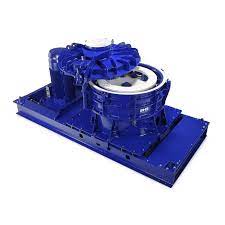
BHS ROTOR IMPACT MILL
The BHS Rotor Impact Mill is a specialized machine used for size reduction, crushing, and grinding applications in industries like mining, construction, and recycling. It operates by accelerating particles within a high-speed rotor and then impacting them against a stationary surface. This impact-based approach efficiently reduces the size of materials and can produce fine, uniform particles.
Product Feature
1. High-Speed Rotor: The mill features a high-speed rotor that generates the kinetic energy required for crushing and grinding operations.
2. Impact Crushing: Material particles are accelerated and impacted against a fixed impact wall, resulting in efficient size reduction.
3. Variable Speed: Some models offer variable rotor speed control, allowing operators to adjust the impact energy and output particle size.
4. Wear Protection: Wear-resistant materials and liners are used to protect the rotor and impact wall, extending the machine's operational life.
5. Customizable: The mill can often be customized to process different materials and achieve specific output sizes and particle distributions.
6. Minimal Heat Generation: The impact-based process generates less heat compared to traditional grinding methods, preserving material quality.
7. Safety Features: Safety measures, including emergency stops and safety guards, are integrated into the machine design to ensure operator safety.
8. Efficient Energy Utilization: The design focuses on energy efficiency, reducing power consumption for size reduction operations.
Product Application
1. High Efficiency: The BHS Rotor Impact Mill delivers high crushing and grinding efficiency, reducing processing time and energy consumption.
2. Versatility: It can handle a wide range of materials, including abrasive or hard-to-crush substances, making it suitable for various industries and applications.
3. Precise Particle Control: Operators can control the output particle size and distribution, ensuring consistency and meeting specific product requirements.
4. Cost Savings: Improved efficiency, reduced wear, and lower energy consumption contribute to cost savings in material processing.
5. Resource Recovery: The mill facilitates resource recovery by efficiently processing and reducing various materials, such as industrial by-products.
6. Environmental Benefits: Efficient size reduction processes help minimize waste and reduce environmental impact.
7. Product Quality: Consistent particle sizes enhance the quality of end products, suitable for further processing or final use.
8. Reduced Heat Generation: The impact-based milling process generates less heat, preserving the integrity of temperature-sensitive materials.
9. Safety: Built-in safety features protect operators and equipment during operation, ensuring a safe working environment.
10. Customization: Tailoring the mill to specific material and processing requirements enhances its effectiveness and versatility.




